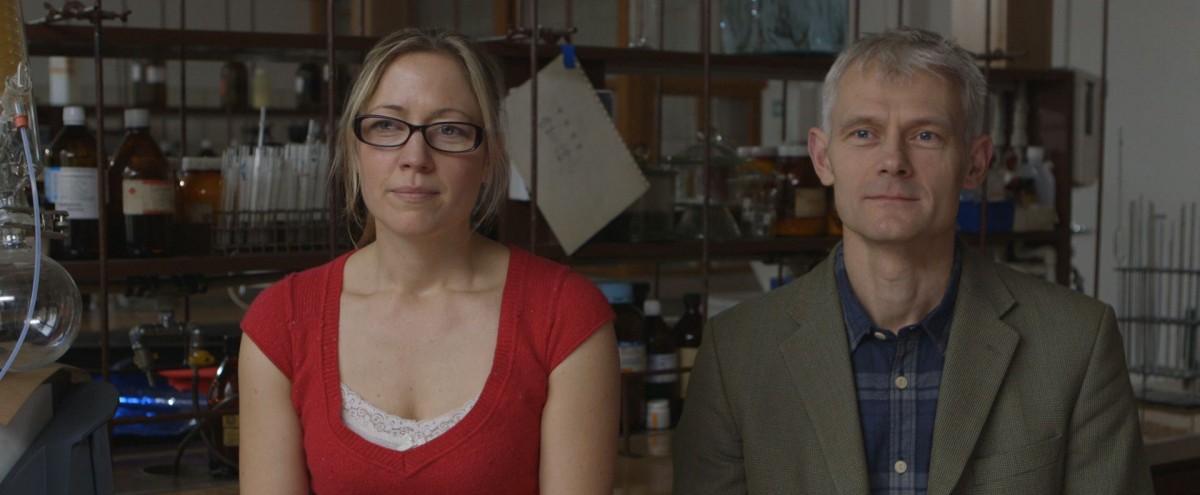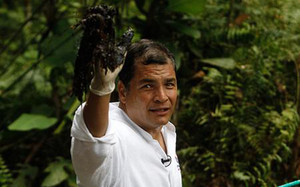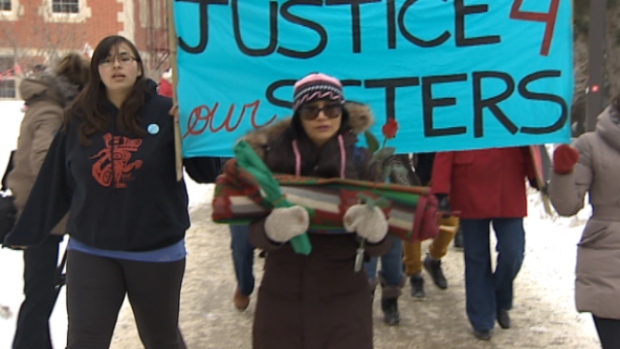
By Johnny Finn, reposted from Human Geography, Mar 1, 2015. The full version of this interview with Naomi Klein will appear in Human Geography, vol. 8, no. 1 (2015).
Johnny Finn, Department of Sociology, Social Work, and Anthropology, Christopher Newport University
In Naomi Klein’s latest book, This Changes Everything: Capitalism vs. the Climate (Simon & Schuster, 2014), the activist, journalist, and author lays out an argument that will probably be familiar to many readers of Human Geography. Carbon is not the problem, but rather a symptom of the real problem: global capitalism.
The book begins by laying out the scientific, economic, and political reality of the current situation. She describes the frightening scenarios for 2°C, 4°C, and 6°C warming that foretell calamitous disaster on a scale that humans might not be able to survive. She identifies a global economic order entrenched in extractive carbon-based mass-production and mass-consumption that has led us to this situation. And she outlines a political system in the US, the world’s second larger carbon emitter, which seems not only unable to do anything about carbon pollution, but whose legislative branch is now run by a political party that overwhelmingly dismisses the science of climate change. All this leads her to an interesting and counter-intuitive conclusion: the climate-denying right actually understands exactly what is needed: systemic change that overthrows global capitalism. To the right this is precisely the reason to pretend that global warming is a hoax. But equally wrong are many, if not most on the left who believe that global carbon emissions can be reduced to such a level so as to avoid catastrophic climate change without systemic change.
In the face of all of this, Klein remains optimistic, utopian even. She sees climate change as an impending disaster ripe with opportunity: not just environmental change, but also a significant reordering of the global political, economic, and social order. She writes:
I began to see all kinds of ways that climate change could become a catalyzing force for positive change—how it could be the best argument progressives have ever had to demand the rebuilding and reviving of local economies; to reclaim our democracies from corrosive corporate influence; to block harmful new free trade deals and rewrite old ones; to invest in starving public infrastructure like mass transit and affordable housing; to take back ownership of essential services like energy and water; to remake our sick agricultural system into something much healthier; to open borders to migrants whose displacement is linked to climate impacts; to finally respect Indigenous land rights—all of which would help to end grotesque levels of inequality within our nations and between them (p. 7).
As Elizabeth Kolbert recently wrote in the New York Review of Books, it’s “a rather tall order.”
Late last week I had the chance to interview Naomi Klein. During the course of our hour-long conversation I asked her about her seemingly disproportional optimism, about the recent US-China bilateral agreement to reduce carbon emissions, about several key gaps in her analysis, about the politicization of science, and about writing on science and policy as an “activist journalist” (her term). The full interview will be published in the next issue of HG (vol. 8, no. 1) along with reviews of the book by Noel Castree, Juan Declet-Barreto, Leigh Johnson, Wendy Larner, Diana Liverman, and Michael Watts. For now, here are some of the key moments from the interview.
Johnny Finn (JF): I’d actually like to start not with a question about your book but rather with a “historic deal” between the US and China that was announced just a couple of days ago to reduce carbon emissions from both countries throughout the coming years.
 Naomi Klein (NK): This deal is taking place in the context of accelerated free trade agreements between China and the US, China and Canada, and other de agreements, markets which are all about liberating the flow of goods and encouraging more consumption. These sorts of baby steps in the right direction are occurring in the context of this unrelenting push for a model of so-called “free trade” that fuels a really wasteful and emissions-intensive form of consumption. We’re still speeding down that highway in the wrong direction and at the same time as there are these small indications in the right direction.
Naomi Klein (NK): This deal is taking place in the context of accelerated free trade agreements between China and the US, China and Canada, and other de agreements, markets which are all about liberating the flow of goods and encouraging more consumption. These sorts of baby steps in the right direction are occurring in the context of this unrelenting push for a model of so-called “free trade” that fuels a really wasteful and emissions-intensive form of consumption. We’re still speeding down that highway in the wrong direction and at the same time as there are these small indications in the right direction.
I do think it is significant what Obama does on Keystone in the next little while, because he really has kicked the can down the road in terms of emission reduction targets he has made—all of the hard stuff kicks in when he’s out of office. So something he can do now instead of just talk is say no to the Keystone XL Pipeline. If he doesn’t, then what he’s doing is locking in an infrastructure for a very high carbon energy source that is designed to last for decades down the road and really making his successors work harder. Making it all more unlikely that they will meet even these paltry targets.
JF: Your book struck me as somewhat dialectical, simultaneously terrifying and almost utopian. You lay out these situations for 2° and 4° and 6° warming that on the upper level could foretell the kind of calamitous global disaster that humans might not survive. Add to that the current global economic and political order. And you look at all of this and you see a situation ripe for opportunity, not just for environmental change but also for significantly reordering the global political, economic, and social order. Maybe I’m just a pessimist but while I think there is a lot to your diagnosis, I don’t know… Especially with the time frame we’re working under, can you convince to be an optimist about this?
NK: Well I think if I didn’t convince you in the book I probably won’t be able to do so in this phone call. And I think that the book has inspired a range of responses that says a lot about our individual state and where we on the spectrum of hope and despair at any given moment. Which shifts at various times, which is not fixed. I think Americans in particular are in a state of deep despair right now… I can’t convince you or anyone else who really feels that this is hopeless. I am making an argument that the fact that it is this bad is potentially a more powerful tool than any we’re currently using to change a system that needs radical change. I think part of the reason why we all feel so much despair in the face of the American political system is that it is so deeply broken… So it doesn’t matter what you think or what you do, it’s non-responsive, it’s not democratic… I think we feel more despair in the face of climate because it is so incredibly absurd. I mean if we look at what’s happening right now with Keystone, that you can have a political class that’s just so craven that they would put the political fortunes of one senator, in the hopes that Mary Landrieu might do better in her run off, above the interest of the planet. I mean it is so crazy, but yet that is what is happening. And so I think there’s a way that climate sort of heightens what we already know: that this is just an amazingly corrupt system…
If we really believed things are as bad as climate scientists are telling us they are, wouldn’t we have to fight differently? Wouldn’t we have to organize ourselves differently? Wouldn’t we make different kinds of arguments? Wouldn’t the tenor of those arguments be different? […] But I don’t think you should be hopeful in the absence of social movements that are organizing on the scale that they should be organizing. My book is a call for a level of organizing and response that is not happening. So should we be hopeful now? Without that, no, there’s no reason to be hopeful. But should we do what we can to try to change those dynamics and build that movement? Well, that’s the political question of our lives… That’s what makes it different than the threat of nuclear war, which was also an existential threat. That actually required an action, we needed to press a button, someone needed to decide to do it. Whereas with climate change, no one needs to take a decision. We’re already doing it.
JF: In a recent article in Salon by Sean McElwee on the resurgence of Marx and Marxist ideas in more mainstream circles, he argues that a major problem for progressives is that many on the left, and especially on the populous left, don’t understand the concept of ideology. He writes that it’s common to hear the left “write and argue as though the entire American political system is controlled by a small cabal of business or political leaders conspiring to fool the masses.” But it’s not that simple, right? In the US we’re beyond just simple consumerism; consumerism is patriotic, and limiting our ability to consume, however recklessly, is framed as and is widely believed to be limiting our freedom. I guess my question for you is this: how do you account for and confront this kind of widespread and deeply entrenched ideology of consumerism?
NK: First of all, it is a relatively recent phenomenon in that there is a tradition of frugality in the United States just a couple of generations back… I think in many ways this ties back to the first book I wrote, No Logo, which was about the elevation of the lifestyle brand and the way that neo-liberalism didn’t just wage war on the public sphere, but as the public sphere shrank and as we became more atomized, the role of shopping in our sense of self and identity increased so that we get to the point where when somebody says, “You can’t shop as much,” it feels like a personal attack, an attack on the self, not a change in behavior that you can adapt to, it feels much more personal. And that’s the success of that lifestyle branding that predates the ‘90s but soared in that period. There’s no doubt that that’s a challenge and that’s why in the book I argue that we won’t win without an ideological battle, that we won’t win without a shift in worldview and values.
And the counterargument is: well there’s no time for that we have to just focus what we can in the short term. But the fact of the matter is this: that’s what we’ve been trying doing for two and a half decades when it comes to climate change. And we’re going backwards. So you know it is possible that going for a leap as opposed to these little baby steps could be a more practical strategy. Which is to say, what is called practical in the mainstream climate discussion, what is seen as serious? It already has a track record of unmitigated failure: it’s more serious to talk about a carbon tax than to talk about having a battle of worldviews, right? Except for what evidence is there that we’re anywhere close to passing a carbon tax? I mean, James Inhofe is going to be Chair of the Senate environment committee. So why not go big? Because this sort of incremental approach is not working. It’s not even delivering the incremental changes that wouldn’t get us there.
JF: One source of tension I felt while reading your book has been kind of the tension between local, bottom-up solutions and approaches and universal, top-down policy prescriptions. On the one hand, for a long time in your work you have argued for decentralization, for more local empowerment. On the other hand you open the book talking about a Marshall Plan for the Earth and other massive, top-down, universal governmental projects. I’m just wondering if you can just talk us through that tension between that universal and local.
NK: Well I do think that are ways of resolving that tension in the way that we design policy, which is why I spend a fair amount of time on what is working about the German transition. I think it is a really good example of how movements can win policy victories, which we need examples of these days. Angela Merkle, she’s not lefty and yet she’s introduced the most ambitious energy transition platform of any non-Scandinavian government in the industrialized world … The design of that energy transition in Germany, it has a bold national plan, bold national targets in terms of what percentage of Germany’s energy is going to come from renewables by which year and a national feed-in tariff program so that it isn’t just local. At the same time, it’s a feed-in tariff program that encourages local ownership, collective ownership, and decentralization of all kind. So I think it’s a good example of how you can reconcile the need or change at scale without resorting to centralized state solutions that often replicate bad patterns of remoteness and unresponsiveness and non-democratic tendencies…
I set out to write a book that accurately diagnosed the problems and could be a tool to weave together different movements, to fight for that next economy and to provide some of the principles that need to animate that next economy. But in terms of laying a blue print for it, I understand why people crave that, but that’s the not the book I intended to write, or that I think I could write. I concede the point that the book is stronger on critiques than it is on what the next economy needs to look like. But politically I really believe that the process of mapping that out, first of all should be specific to different places and should be a democratic process. Maybe that sounds like a cop-out but I really do believe that.
JF: In the recent New York Times review of your book, Rob Nixon describes not only this work, but all of your work—No Logo, Shock Doctrine, and This Changes Everything—as your anti-globalization trilogy. How do you react to this characterization of being “anti-globalization”?
NK: It’s a bit of a throwback, that term, right? We don’t really use it; you don’t even hear it that much any more. I mean, at the time, we always said it’s not an anti-globalization movement. On the liberal end, it’s an anti-corporate globalization movement and on the left side an anti-capitalist globalization movement, and that remains true. I never even understood the word “globalization,” and I don’t use it as you can see in the book. I talk about this particular model of corporate globalization, which was a pseudonym for corporate liberation movement. So I’ve never liked the term. It’s conflated too many things at once, in a way that was never useful.
[There’s something else that] has come up in a few reviews that I’m a bit confused by. This issue of: Is it anti-neoliberal? Or is it anti-capitalist? A few reviewers have made the claim that the case I’m making is against neoliberalism and not against capitalism. And I think I’m really clear in the book, and I don’t know how I could be any clearer: it’s both. That in terms of the tools that we needed to respond to this crisis when it hit in the late 80s and 90s, were the very tools that were under fire by the neoliberal project: regulation, taxation, the very idea of collective action in society and so on. The advancement of free trade created more barriers. But because we have waited as long as we have, and we now need to cut our emissions as deeply as we need to, we now have a conflict not just with neoliberalism, but a conflict with capitalism because it challenges the growth imperative. So I realize this is a two-stage argument, but it’s both.
JF: In the last 30-35 years both within geography and beyond, a substantial group of researchers, educators, and authors have developed the field of political ecology. It now consists of more than 20 major books, hundreds of academic articles, probably thousands of courses taught around the world, and there’s really no mention of political ecology in your book. Why not?
NK: Well…I think it’s probably a fair enough challenge and I think one of the pitfalls of writing a really interdisciplinary book is that I’m not going to be 100% up on the literature in any of the fields. I was keenly aware of the fact that in every field that I touch on, and I touch on a lot of them, I’m standing on so many shoulders. There’s six pages of acknowledgements and all I can think of are the people I forgot. Part of it, in writing for a popular audience as opposed to an academic audience, is that there’s a constant name checking in academic writing and in popular writing there’s a lot less of it. Just for readability and flow and I think that does run the risk of people feeling unacknowledged, especially when I’m getting all of this popular attention and they haven’t. I feel bad about that if I screwed that up.
JF: Another question I think is along the same lines and comes based on a recent Guardian piece that Kate Raworth wrote, suggesting that a better name for the Anthropocene might be the “Manthropocene.” Compared to the number of male scientists who you cite, you cite very few women scientists and researchers. And there are many women doing really important research, especially in the policy realm on climate change. Why do you cite so many men compared to women?
NK: You think that that’s true? I’m not sure. I feel like I was aware of that in the first half of the book. I feel like in the second half of the book that the balance shifts. But I was aware of it in the first half of the book, and I think it’s definitely true in terms of the climate science and in some of the more wonky tax stuff, although I’m always quoting Kevin Anderson and Alice Bows-Larkin more so than I quote anybody else. Part of it is just there was a certain team of climate scientists who just helped us a lot, and they were all men, that is true and that’s not good. And the geoengineering world is overwhelmingly male.
I think I find the climate debate to be overwhelmingly male dominated even though the field is not. In terms of people who make the most noise, who blog the most, who get heard… Part of what I’m trying to do with this book is make people who don’t feel welcome in this world, feel like they could also talk about climate change. And part of it is it that it’s a very very wonky world. There’s the science side of it but then there’s the policy world, which is just as male-dominated if not more. And even the big green groups. Even though the environmental justice movement is overwhelmingly led by women at the grassroots level, there’s been some very strong analyses looking at how male-dominated the big green groups are. But I would think that a book like mine should try to fix some of that, in terms of who is treated as an expert. I don’t think I did enough. I certainly tried not to replicate that. I think it’s fair enough to say in terms of the climate science that most of the climate experts, besides, Alice, are men, Alice and Penny Chisholm. I did think it’s funny, too, about people who get cited. It’s a self-reinforcing cycle in terms of who gets cited. People worry more about offending men because they tend to have bigger egos.
I think a lot of the most important and wisest voices in the book are women and many of them women of color, like Arundhati Roy and Angélica Navarro, who I start the book with. The film in particular I think does a better job than the book of upending some of these notions of who is an expert.
JF: Ok, last question: given how highly politicized that climate change is, especially in the US, and really the strong politicization of everything in American politics right now, are you concerned that your book might simply further the politicization of this issue, that it might actually backfire by making broad based climate action, exactly the kind of climate action that we need, even harder because of the politicization surrounding it?
NK: I get the concern, but I can’t see how it could be more politicized than it already is in terms of how it’s perceived on the right. I mean, the left, liberals are scared of the book. But the right, you know, they already thought this. This is the whole point, but one of the things that’s so frustrating about Obama is that he gets all of the backlash as if he was doing something, as if he was doing something radical. So he may as well! That’s assuming he actually wants to. Given that he gets treated as a socialist when he does the most minor neoliberal reforms, he may as well go a little bit further. I don’t think that the right in the United States could be more convinced that climate change is a socialist plot, so I’m not all that worried about it. The other issue is just that this book is disruptive to the current narrative, but it’s not as if that narrative was working. It’s not as if I’m coming into a movement, a climate movement, that was moving from strength to strength and introducing an argument that could sabotage it. I’m introducing a debate into a movement that is losing, big time, on every front. So, I don’t think we have anything to lose in trying a different approach. There’s a huge amount of fear and I acknowledge that it is risky. If I were doing this 15 years ago or 10 years ago even, I think that that argument would have carried more weight. I’ve said this in other interviews, we tried it their way: pretending we could do this and no one would even notice. And it didn’t work. So let’s try telling the truth and see what happens. SOURCE
* Thanks to Colleen Garrison for her assistance transcribing this interview.
RELATED:

DON’T MUDDLE ENERGY EFFICIENCY WITH REDUCING EMISSIONS




